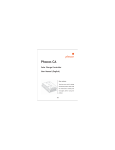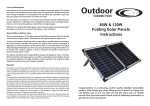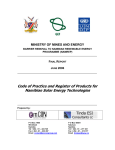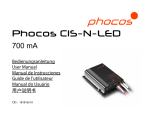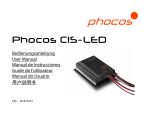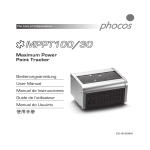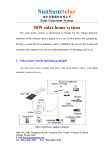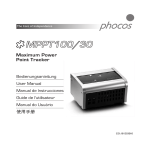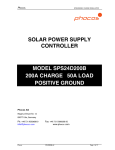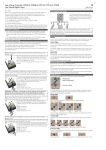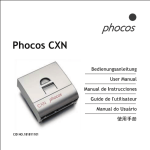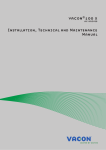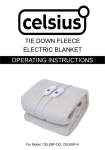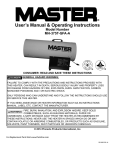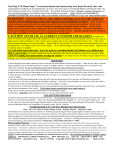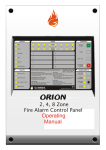Download CA06-2, CA08-2
Transcript
Connect the wires leading to the battery with correct polarity. To avoid any voltage on the wires, first connect the
controller, then the battery. Keep in mind the recommended wire length (min. 30 to max approx. 100 cm) and the
wire size:
CA06-2: min. 2.5 mm²
CA08-2: min. 4 mm²
CA06-2, CA08-2
Solar charge controller
User Manual(English)
Dear client,
Thank you very much for buying a Phocos product. With your new CA controller
you own a state-of-the art device which was developed according to the latest
available technical standards. It comes with a number of outstanding features, like:
§ 3 LEDs for a clear, readable display of the state of charge
§ 16 mm² connector clamps
§ Temperature compensation
§ Electronic protection without fuses
This manual gives important recommendations for installing, using and configuration as well as remedies in case of problems with the controller. Read it carefully
in your own interest. Please take note of the safety and usage recommendations at
the end of this manual.
Description of Functions
§ The charge controller protects the battery from being overcharged by the solar
array and from being deeply discharged by the loads. The charging takes place
through multiple stages which include automatic adaptation to the ambient temperature for optimal charging of the battery
§ The controller is intended for use at 12 V system voltage.
§ The charge controller has a number of safety and display functions.
Mounting and Connecting
The controller is intended for indoor use only. Protect it from direct sunlight and
place it in a dry environment. Never install it in humid rooms (like bathrooms).
The controller measures the ambient temperature to determine the charging voltage. Controller and battery must be installed in the same room.
The controller warms up during operation, and should therefore be installed on a
non flammable surface only.
REMARK: Connect the controller by following the steps described below to avoid
installation faults.
When mounting the controller with screws, make sure to
use screws that suit the attachment material (use screws
with 4 mm shaft and max. 8 mm head diameter, no
counter sunk). Keep in mind that the screws also have to
carry the force applied by the wiring.
Make sure that the ventilator slits on the sides are unobstructed.
A DIN Rail mounting plate is available as an accessory (CX-DR2). This allows
mounting the controller on a standard 35mm DIN rail. Place the controller on the
mounting plate, and use the screws supplied with the mounting plate to fix it to
the controller.
WARNING: If the battery is connected with reverse polarity, the charge controller will also give the wrong polarity on the load terminals. Never connect
loads in this situation!
REMARK: Keep in mind the recommendations of your battery manufacturer. We
strongly recommend connecting a fuse directly to the battery to protect any short
circuit at the battery wiring. The fuse type must be in accordance with the charge
controller's nominal current:
CA06-2: 20A, CA08-2: 20A
Connect the wires leading to the solar array with correct
polarity. To avoid any voltage on the wires, first connect
the controller, then the solar array. Keep in mind the recommended wire size:
CA06-2: min. 2.5 mm²
CA08-2: min. 4 mm²
Starting up the Controller
System Voltage
The controller is intended for use at 12 V system voltage.
Battery Type
The controller does not generate an equalization charge, and is therefore suitable
for use with lead acid batteries with liquid electrolyte (vented battery) and lead
acid batteries with solid electrolyte ('gel' or 'fleece' type).
Recommendations for Use
The controller warms up slightly during normal operation.
The controller does not need any maintenance or service. Remove dust with a dry
tissue.
It is important that the battery gets fully charged frequently (at least monthly).
Otherwise the battery will be permanently damaged.
A battery can only be fully charged if not too much energy is drawn during charging. Keep that in mind, especially if you install additional loads.
Display Functions in normal operation
The controller is equipped with 3 LEDs for display of the operating status.
Charge display
State of charge display
REMARK: place positive and negative wires leading to the solar generator close to
each other to minimize electromagnetic effects.
REMARK: Solar panels provide voltage as soon as exposed to sun light. Keep in
mind the solar panel manufacturers recommendations in any case.
Connect the wires leading to the loads with correct polarity. To avoid any voltage on the wires, first connect the wire
to the load, then to the controller. Keep in mind the recommended wire size:
CA06-2: min. 2.5 mm²
CA08-2: min. 4 mm²
Load status display
In normal operation mode, the controller displays the state of charge (available energy) of the battery, a possible low state of charge, and the status of the load output.
Charge display
Solar array does not
supply electricity
State of charge display
(green light on)
Solar array does
supply electricity
Grounding the Solar System
Be aware that the positive terminals
of the controller are connected internally and therefore have the same
electrical potential. If any grounding is
required, always do this on the positive wires.
REMARK: If the device is used in a vehicle which has the battery negative on the
chassis, loads connected to the regulator must not have an electric connection to
the car body. Otherwise the Low Voltage Disconnect function and the electronic
fuse function of the controller are short circuited.
State of charge
State of charge
OK
low (light on)
When the state of charge is indicated as low, it is recommended to use the remaining energy economically. The charge controller will subsequently switch off
the load.
Load status display
In case of deep discharge or overload/short-circuit, the load output is switched off.
This is indicated by:
Normal operation
Low voltage disconnect
(light on)
(light flashing)
Overload or
Short-circuit of load
Low Voltage Disconnect Function (LVD)
The controller is equipped with a low voltage disconnection function to protect
the battery against a deep discharge: This function is controlled by the voltage, and
automatically switches off the load output at a battery voltage lower than 11.5 V.
As soon as the battery reaches a voltage of 12.8, the load output is switched on
again.
Safety Features
The controller is protected against wrong installation or use:
At the solar
At the battery At the load termiterminal
terminal
nal
Battery connected
Unrestricted.
Normal operation Unrestricted
with correct polarity
Battery connected
Yes, if only the batUnrestricted
Unrestricted
with wrong polarity
tery is connected.
Load output is proYes, if only the batReverse polarity
Unrestricted
tected. Loads might
tery is connected.
be damaged.
Unrestricted
CAUTION: Battery Unrestricted
Short circuit
Unrestricted
must be protected
by fuse.
Controller switches
Overcurrent
No protection ----------------------off.
No connection
Unrestricted
Unrestricted
Unrestricted
Reverse Current
Unrestricted
----------------------- ----------------------Varistor 56 V,
Overvoltage
Max. 30 V
No protection
2.3 J
Normal opera- Controller switches Controller switches
Undervoltage
tion
off load terminal. off load terminal.
WARNING: The combination of different error conditions may cause damage to the controller. Always remove an error before you continue connecting the controller!
Error Description
Error
Display
Reason
Battery is low
(Light on)
Loads are not supplied
Battery is empty
again after a short
time
Battery is not being
charged during the
day
Overcurrent/
Short circuit
of loads
Remedy
Load will reconnect as
soon as battery is
recharged.
Switch off all loads. Remove short circuit.
Controller will switch
on load automatically
after max 1 minute.
Battery has
low capacity
Change battery
(Light on)
Solar array
Remove faulty connecfaulty or
tion/reverse polarity
wrong polarity
General Safety and Usage Recommendations
Intended Use
The charge controller is intended exclusively for use in photovoltaic systems with
12 V nominal voltage, and in conjunction with vented or sealed (VRLA) lead acid
batteries only.
Safety Recommendations
§ Batteries store a large amount of energy. Never short circuit a battery under any
circumstances. We recommend connecting a fuse (slow acting type) directly to
the battery.
§ Batteries can produce flammable gases. Avoid making sparks, using fire or any
naked flame under any circumstances. Make sure that the battery room is ventilated.
§ Avoid touching or short circuiting wires or terminals. Be aware that the voltages
on specific terminals or wires can be up to double the battery voltage. Use isolated tools, stand on dry ground and keep your hands dry.
§ Keep children away from batteries and the charge controller.
§ Please observe the safety recommendations of the battery manufacturer. If in
doubt, consult your dealer or installer.
Liability Exclusion
The manufacturer shall not be liable for damages, especially on the battery, caused
by use other than as intended or as mentioned in this manual or if the recommendations of the battery manufacturer are neglected. The manufacturer shall not be
liable if there has been service or repair carried out by any unauthorized person,
Technical Data
Nominal voltage
Boost voltage
Float voltage
Load disconnect voltage
Load reconnect voltage
Temperature compensation
Max. solar panel current
Max. load current
Dimensions
Weight
Max. wire size
Self consumption
Ambient temperature range
Case protection
12 V
14.5 V
13.7 V (25°C)
11.5 V voltage controlled (25°C)
12.8 V
-4 mV/cell*K
CA06-2: 5 A
CA08-2: 8 A
at 50°C ambient temperature
CA06-2: 6 A
CA08-2: 8 A
at 50°C ambient temperature
80 x 100 x 32 mm (w x h x d)
180 grms
16 mm² (AWG #6)
4 mA
-25 to + 50 °C
IP 20
Subject to change without notice. Version: CA2m_050419
Made in one of the following countries: Germany – China – Bolivia - India
Phocos AG – Germany
www.phocos.com


